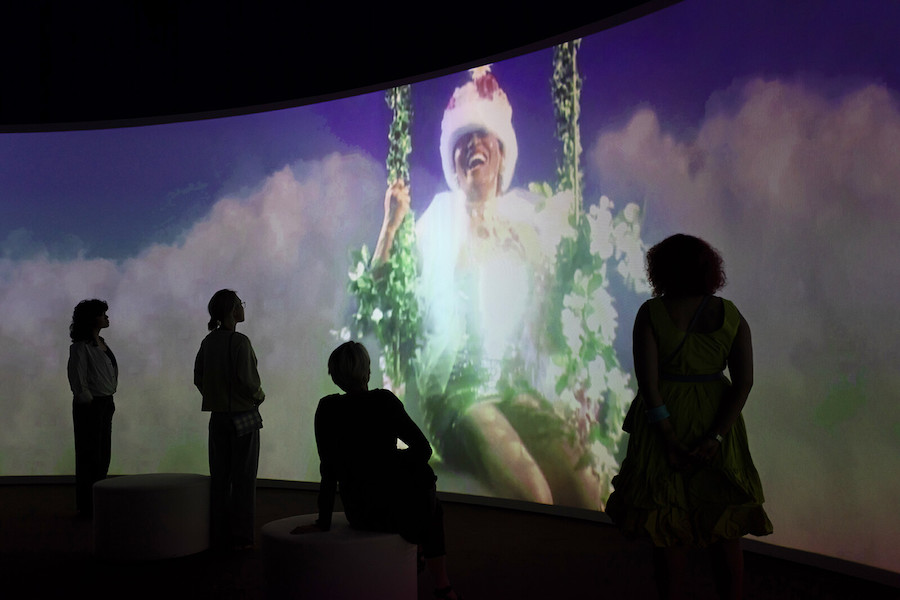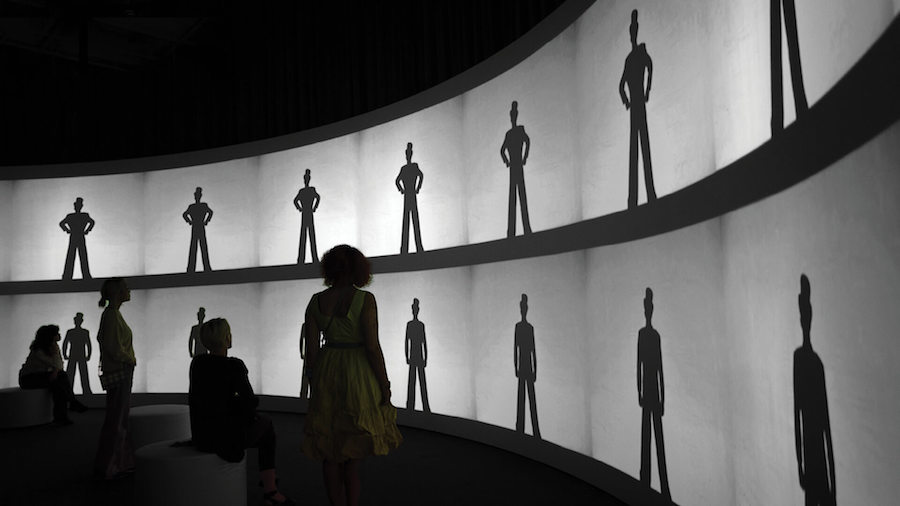

Solitamente le mostre che preferisco sono collettive e biennali.
In questo caso, per il 2023, direi che ci sono due mostre personali (retrospettive) che hanno invece rappresentato qualcosa di importante.
In entrambi i casi, però, siamo di fronte ad artisti plurali, proteiformi, multidisciplinari che hanno anche fatto parte di movimenti attivisti e rivendicato i diritti civili.
La decostruzione delle strutture di potere e la messa in discussione di narrative occidentali su razza, genere e classe mi sembra il loro comune denominatore.
Marco Scotini
Carrie Mae Weems: Reflections for Now
Barbican Art Gallery, London
22 June – 3 September 2023
Opening 22 June 2023, Barbican Art Gallery has presented the first major solo exhibition of Carrie Mae Weems in a UK institution. Widely considered to be one of the most influential American artists working today, Weems (b.1953) is celebrated for her exploration of cultural identity, power structures, desire, and social justice through a body of work that develops questioning narratives around race, gender, history, class and their systems of representation.
Highlighting her remarkably diverse and radical practice, this survey brings together an outstanding selection of photographic series, films, and installations spanning over three decades, many of which have never been seen before in the UK. Presenting the development of her unique poetic gaze and formal language from the early 1990s to the present day, this exhibition reflects on Weems’s pioneering career. On display are works from her early iconic Kitchen Table Series (1990) which explores how power dynamics are articulated in the domestic sphere and the potential of the home as a space for resistance, to her acclaimed series Roaming (2006) and Museums (2016) where Weems’s muse confronts architecture as the materialisation of political and cultural power. Her oeuvre challenges dominant ideologies and historical narratives created by and disseminated within science, architecture, photography, and mass media.
Activism is central to Weems’s artistic practice, as she has stated:
“My responsibility as an artist is to work, to sing for my supper, to make art, beautiful and powerful, that adds and reveals; to beautify the mess of a messy world, to heal the sick and feed the helpless; to shout bravely from the roof-tops and storm barricaded doors and voice the specifics of our historic moment.”
Weems came to prominence in the early 1980s through photographic work that questions how the representation of the Black subject, particularly within the United States, has historically reproduced systemic racism and inequality. Highlight works in the exhibition include From Here I Saw What Happened and I Cried (1995–6), a series which appropriates 19th and 20th century photographs of African and African American people to underline how the representation of this diaspora has been historically reduced to a set of degrading stereotypes. These works are presented alongside more recent works such as Constructing History (2008), in which Weems worked with college students to recreate landmark moments in twentieth century history to interrogate how they still affect our present, and Lincoln, Lonnie, and Me (2012), an installation that, inspired by the Pepper’s Ghost theatres of the 19th century, examines how the collective traumas of the past are being constantly renegotiated.
(Estratto del comunicato stampa)

Jimmie Durham: humanity is not a completed project
a cura di Kathryn Weir
23.12.2022 — 08.05.2023
MADRE, Napoli
Artista, poeta, performer, saggista e attivista, Jimmie Durham (1940-2021) è una figura unica nella storia dell’arte internazionale dell’ultimo mezzo secolo. Il suo lavoro affronta i fondamenti della cultura europea e nordamericana, decostruendo idee e categorie consolidate. Questa prima mostra retrospettiva dopo la sua scomparsa nel tardo 2021 presenta oltre 150 opere, alcune delle quali mai esposte. Crea collegamenti tra periodi temporali all’interno di sequenze tematiche, combinando elementi cronologici con un approccio narrativo, includendo riferimenti a mostre storiche che racchiudono gli esperimenti da lui condotti sulle strategie spaziali. Nel corso di una carriera di oltre cinquant’anni, Durham ha dedicato la sua pratica alla decodifica critica delle immagini e dei simboli naturalizzati che sono alla base dei sistemi culturali dominanti. Le sue opere, caratterizzate da una forte vena umoristica, spaziano tra sculture, video, poesie, performance, installazioni, dipinti, disegni, collage, stampe e saggi. Costruendo “combinazioni illegali con oggetti rifiutati”, attraverso materiali naturali e industriali, Durham ha generato rotture all’interno delle convenzioni del linguaggio e della conoscenza.
Questa mostra è un omaggio a un artista il cui lavoro proteiforme e stratificato è fondamentale per la comprensione dell’arte contemporanea e dei suoi possibili futuri scenari. Il titolo, tratto da una stampa di Durham, sottolinea il suo progetto di relativizzare, come culturalmente specifiche, le nozioni universalizzanti e teleologiche dell’essere umano, caratteristiche della modernità europea. La sequenza di apertura definisce la critica di Durham alle nozioni di autenticità, identità, verità e nazione dentro a sistemi di consumo capitalista – “Veracity” e “Voracity”, si legge su due delle sue prime insegne scultoree. Dal 1969, mentre frequentava la scuola d’arte a Ginevra, Durham ha fatto parte di una rete di pensatori e attivisti coinvolti nei movimenti di liberazione del Terzo Mondo e degli indigeni, e nel 1973 è tornato negli USA per partecipare alle lotte per i diritti civili. Ha collaborato con il Central Council of the American Indian Movement (AIM), contribuendo a fondare AIM: Women of All Red Nation (WARN), e poi dal 1975, come direttore fondatore dell’International Indian Treaty Council (IITC) presso le Nazioni Unite, ha lavorato all’integrazione nel diritto internazionale della “Dichiarazione universale dei diritti dei popoli indigeni”. Nel 1979 Durham si dimette dall’AIM, esprimendo dubbi sulla sua autonomia politica, e si concentra nuovamente sulla produzione artistica, pur dichiarando la sua intenzione di mantenere un impegno nelle lotte in corso.
(Estratto dal comunicato stampa)










